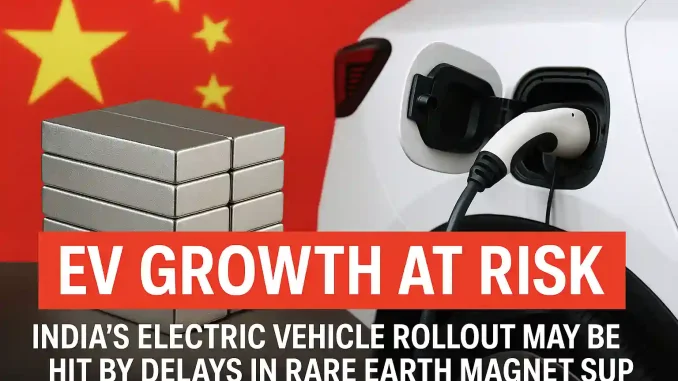
As India accelerates its transition to a cleaner, greener mobility future, a looming threat casts a shadow over the country’s electric vehicle (EV) ambitions: the growing vulnerability of its supply chain—especially concerning the availability of rare earth magnets, critical components in EV motors. With the majority of these materials sourced from China, recent signs of potential delays and export restrictions could jeopardize India’s roadmap for electric mobility.
The Strategic Importance of Rare Earth Magnets
Rare earth magnets, particularly neodymium-iron-boron (NdFeB) magnets, are essential for the permanent magnet synchronous motors (PMSMs) used in most electric vehicles. These motors are prized for their high power density, energy efficiency, and compact size—making them ideal for electric drivetrains.
However, these rare earth magnets rely heavily on raw materials like neodymium, dysprosium, and praseodymium—elements that are difficult to mine and refine, and are almost exclusively controlled by China, which commands over 90% of the global supply chain.
Why India Is at Risk
India’s EV industry is still in its nascent stages, but it’s growing rapidly. In 2024 alone, EV sales crossed the 1.6 million mark, with the government targeting 30% EV penetration by 2030. However, the bulk of components for EV motors—including rare earth magnets—are imported, mostly from Chinese suppliers.
Recent reports suggest:
- Increased scrutiny and longer lead times in China’s export process for rare earths, partly due to stricter environmental controls and rising domestic demand.
- Potential geopolitical tensions and trade barriers that may affect the free flow of these materials.
- A sharp rise in prices of rare earth elements, making EV production costlier and less predictable.
These developments pose a serious risk to India’s EV production pipeline, particularly for two- and three-wheelers, where cost sensitivity is highest.
Impact on Indian EV Makers
Indian EV manufacturers—especially startups and small to mid-size OEMs (Original Equipment Manufacturers)—are likely to feel the brunt of the disruption. Here’s how the impact could unfold:
- Production delays: A slowdown in the availability of magnets could delay vehicle rollouts, especially for models set to launch in the second half of 2025.
- Increased costs: Rising rare earth prices could eat into margins, potentially leading to price hikes for end consumers.
- Technology compromise: Some OEMs might be forced to switch to inferior motor technologies (like induction motors), which can lower vehicle efficiency and reduce driving range.
- Investor concerns: Disruptions in supply chains could affect investor confidence in the sector, particularly for startups that are scaling manufacturing and dependent on timelines.
China’s Strategic Position and India’s Dependence
China’s control over rare earth materials is not new. For decades, the country has invested heavily in mining, refining, and manufacturing infrastructure. It now uses its dominance not just as a commercial advantage, but as a strategic tool in global trade and diplomacy.
India, meanwhile, has yet to build meaningful capacity in this domain. Though India has modest reserves of rare earths, particularly in Odisha and Andhra Pradesh, it lacks the infrastructure and investment to extract and process them at scale.
Currently:
- Over 80% of India’s rare earth magnets are imported from China.
- India has no large-scale commercial magnet manufacturing facilities.
- Local R&D in magnet recycling or substitutes is still in early stages.
Steps India Is Taking (and Needs to Take)
The Indian government is aware of the strategic implications and is taking initial steps to address the threat. These include:
- Rare Earth Exploration: The Department of Atomic Energy and Indian Rare Earths Limited (IREL) are mapping reserves and planning expanded mining operations.
- PLI Schemes for Advanced Chemistry Cell and Critical Minerals: Aimed at encouraging domestic value addition in EV and battery supply chains.
- Strategic Partnerships: Talks are ongoing with countries like Australia and the U.S. to secure long-term access to rare earth resources and technologies.
- Public-Private Collaboration: NITI Aayog and Invest India are working to promote domestic magnet manufacturing and attract foreign players to set up local plants.
However, experts warn that unless action is taken urgently, the benefits of these plans may come too late to support India’s immediate EV rollout goals.
The Global Context: India Not Alone
India is not the only country vulnerable to China’s dominance. The U.S., Europe, Japan, and South Korea are also heavily dependent on Chinese rare earth exports. In response, global initiatives have sprung up to diversify sources, including mining projects in Australia, Vietnam, and Canada.
India has the opportunity to align itself with these global efforts, not just as a consumer but as a potential player in refining or magnet manufacturing—especially with the right policy and investment ecosystem.
The Road Ahead: Balancing Speed and Self-Reliance
India’s electric vehicle future holds immense promise—environmentally, economically, and strategically. But it is also intricately tied to the resilience of its supply chain. The current crisis around rare earth magnet supplies is a wake-up call to accelerate efforts towards self-reliance, research, and diversification.
While the 2030 EV targets are still within reach, they hinge on India’s ability to build secure, localized supply chains. A delay today in rare earth sourcing could lead to a much bigger slowdown tomorrow in India’s green mobility dream.
Leave a Reply